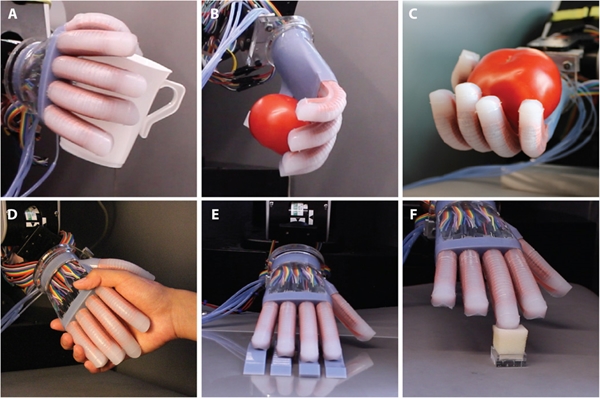13 December 2016. A robotic hand with built-in sensors that can sense fine differences in shape and texture is being developed in an engineering lab at Cornell University in Ithaca, New York. A team from Cornell’s Organic Robotics Lab, led by engineering professor Robert Shepherd, describes their invention in the 6 December issue of the journal Science Robotics, the first issue of this journal.
Shepherd and colleagues are seeking lighter weight and more responsive means for prosthetic devices to sense the nature of their immediate surroundings. Most current methods for prosthetics to assess textures and shapes, for example, use stretchable sensors that measure changes in electrical properties of materials. While these techniques may be technically feasible, say the authors, they often are complex mechanical systems, requiring motors that are slow to react, and in some cases use chemically unstable materials.
Doctoral student and first author Huichan Zhao says the Cornell team is aiming to develop a process that matches as closely as possible the human sensory experience. “Most robots today have sensors on the outside of the body that detect things from the surface,” says Zhao in a university statement. “Our sensors are integrated within the body, so they can actually detect forces being transmitted through the thickness of the robot, a lot like we and all organisms do when we feel pain, for example.”
The researchers base their sensors on optical waveguides, electronic channels that direct light waves, integrated into the materials. The sensors use optical circuits that still stretch, but they also measure the amount of light lost when the sensors bend, which can be calculated as values of curvature, elongation, and force. These values can then be translated into haptic sensory experiences for the system connected to the sensors.
The team built the sensors with a combination of 3-D printing and lithography. The mold for the cladding, the outer layer of the sensor, was 3-D printed, with four successive layers fabricated inside the cladding that hold three separate waveguides. A light-emitting diode is placed at one end of the sensor as the light source and photodiode or detector at the other end. The researchers say the sensors are easy to make, chemically inert, and can be readily integrated into the fingers of a prosthetic hand, which they designed in their lab.
The team tested their prosthetic hand with optical sensors to detect items of different heights and to distinguish various curved and rough surfaces as indicators of textures. The tests then progressed into more practical tasks, including sensing the scroll wheel and buttons on a computer mouse, and assessing the softness of different objects. Those objects included a polyurethane sponge, silicone rubber, a ripe tomato, and an unripe tomato, with the hand distinguishing between three ripe and unripe tomatoes in a separate test.
The authors say their prototype prosthetic hand can be improved with a greater density of sensors in the device and more powerful LEDs in the sensors, as well as more powerful algorithms, including machine-learning, to process a higher volume of data they generate. Cornell University filed for a patent on the stretchable waveguide fabrication techniques, with Shepherd and Zhao listed as inventors.
Read more:
- Spinal Cord Injury Rehab Device in Development
- Autonomous Robot Shown Better at Soft-Tissue Surgery
- NIH Funding New Robotics for Disabled, Children
- Robotic Exoskeleton Developed for Upper-Body Rehab
- Robot for Reaching Children With Autism Demonstrated
* * *


 RSS - Posts
RSS - Posts
You must be logged in to post a comment.